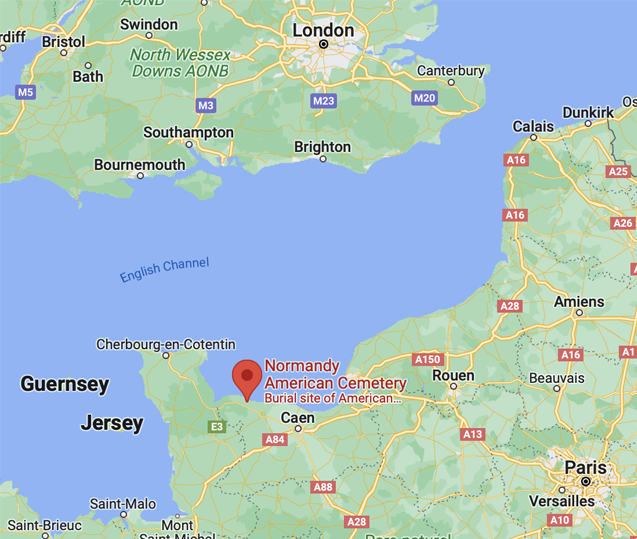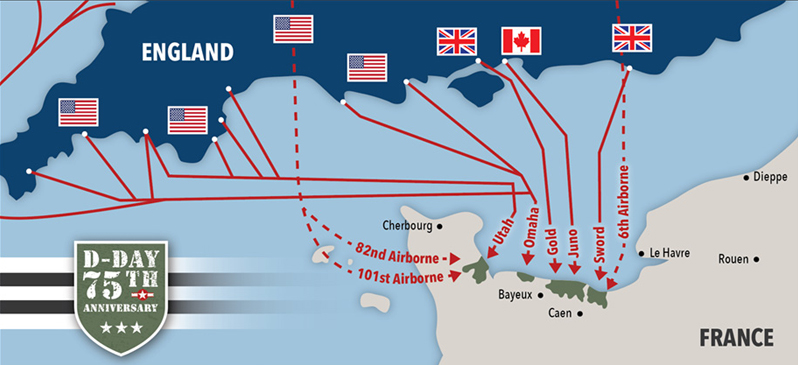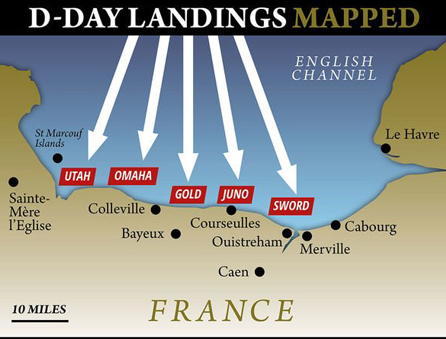Normandy Area Exploration
June 4-5, 2022

 | After the two days of exploration in London, the tour group was headed for mainland France. The plan was to explore the Normandy area with the beaches used on D-Day, June 6, 1944 for the Normandy invasion by Allied troops. Then they were to travel to Rouen and then Paris, France. |
On a full day of travel, the tour group traveled by bus to Portsmouth and boarded a ferry for the crossing to Caen in the Normandy area. The crossing from Portsmouth to Caen took about six hours. Elyse's trip across the English Channel was in the same area as Rod and Brenda's approach to England in 1966. We approached by traveling first to Le Havre, traveling well offshore from the critical beaches used on D-Day. Then we crossed the channel to the deep-water port at Southampton and took the boat train to London. Since Elyse's tour took her to the beaches of D-Day, she was also very close to where Edgar landed on Utah Beach on June 9, 1944, just three days after D-Day. Edgar and his group hiked inland for two days to a location where they were to prepare a landing strip. Edgar worked on maintenance and repair of fighter aircraft, and they camped there. |  |

By traveling to Caen, Elyse's tour group went right into the area of maximum activity of the Normandy Invasion on D-Day.
 |  |
This is one of Elyse's views of the English Channel while she was crossing to Caen. Their landing place was near the east end of the beaches of D-Day, whereas Edgar's landing was on the far west end at Utah Beach, and our contact was west of the main battle zone at Le Havre.
 |  |
The photo above left is in Saint Paul du Vernay where they spent the night. On the next day they visited Sainte-Mere-Eglise, which is notable as the first town liberated in the Allied assault and is celebrated as the gateway from the landing beaches. Rod celebrates it for a different reason, as the first town in France that his brother Edgar visited after he landed on Utah beach on June 9, 1944.
| It looks like Sainte-Mere-Eglise has collected quite a crowd. It was a time of a major celebration, and Elyse noted that many had on American uniforms to celebrate the role of the U.S. in their liberation. In the first three days, Sainte-Mere-Eglise had been liberated from the Germans and Edgar spoke of visiting it a number of times. The first advance airstrip they prepared was near Sainte-Mere-Eglise, and they had walked to that location from Utah Beach. Sainte-Mere-Eglise is six miles from Utah Beach. |  |
 | They watched a military exercise at Cirqueville-en-Bessin, which might have been part of the celebration of the Normandy invasion since it was close in date to D-Day. |
Some of the more difficult obstacles the Allies faced: narrow beach and high cliffs, with barbed wire still remaining. |  |
 | One of the many gun emplacements along the beaches that the Allies faced. They got to go down into this gun emplacement. |
Elyse did get to walk on at least one of the Normandy beaches. Your head must spin with memory when you walk! This beach was at Vierville-sur-Mer. |  |
 | A profound reminder of the high price paid to meet Nazi aggression and preserve the freedom of the world. This location is Collevile-sur-Mer. |
Visit to Rouen, France
On June 6 they traveled to the city of Rouen, France and visited the amazingly ornate cathedral there. Rouen is a city in northern France which is situated on the Seine River, the same river that passes through Paris. Rouen was severely damaged by bombing during World War II, but no damage to the cathedral appears in this view. |  |
 | The towering spires of the Rouen Cathedral. Note the different types of spires. Maybe still some repair going on here from WWII damage. |
One of the ornate entrances to the Rouen Cathedral. |  |
 | Elyse did get to walk on the streets of Rouen. This narrow stone street reminds us of city streets in other parts of Europe, like some we explored in Spain. |
 |  |
 | Street scenes in downtown Rouen, France. |
Elyse got to see this painting of Joan of Arc on the wall of a building in Rouen. Joan of Arc met her death in Rouen when she was burned at the stake in 1431 when she was just 19 years old. But later she was to become a hero as a martyr and there is today the Church of St Joan of Arc. She was fighting on behalf of the French against the English and was captured by the English. It was only in 1909 that Joan was beatified and in 1920 that she was canonised and became a saint of the Catholic Church. It was a big turnaround for someone who had been excommunicated and executed for heresy.  The Joan of Arc Church has sweeping roof lines designed to look like the flames that took her life. |  |
| Visit to Paris |
2022